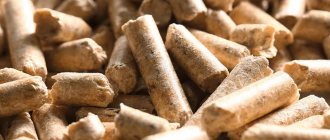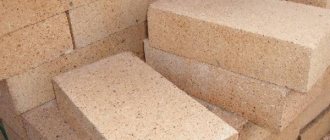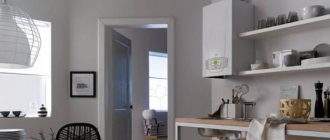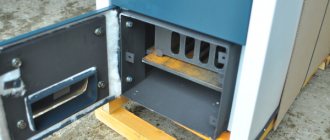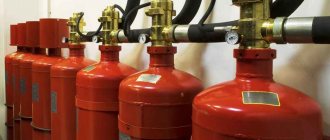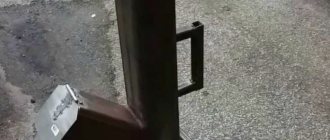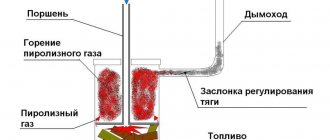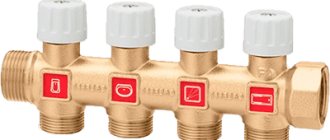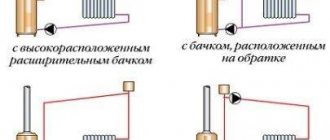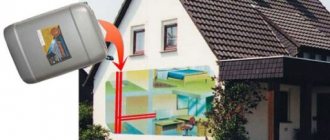How to calculate pellet consumption
Considering the fact that fuel is supplied in bulk or packaged in bags, it is, in principle, not difficult to calculate the consumption of pellets per 1 kW or per 1 m2.
There is no need to convert weight units into volume, since delivery always occurs in kilograms, and the heat of combustion of fuel is also measured in kW per 1 kg of weight. Good quality granules have excellent calorific value; burning 1 kg of such fuel produces almost 5 kW of thermal energy. Accordingly, to get 1 kW of heat for heating a house, you need to burn about 200 grams of pellets. The average consumption of granules per unit area can be easily determined based on the fact that heating each 1 m2 of area requires 100 W of energy
One condition is important: the ceiling height should be within 2.8-3 m. 100 W of heat will be obtained from 20 grams of granules, it would seem simple arithmetic. But it was not there
The figures presented above are correct if the pellet boiler has absolute efficiency - 100% efficiency, but this does not happen in real life. In fact, the efficiency of such heat generators, although higher than that of solid fuel boilers, is still only 85%. This means that after burning 1 kg of pellets in the furnace of the unit, not 5 kW of energy will be obtained, but 5 x 0.85 = 4.25 kW. Conversely, to release 1 kW of heat in pellet boilers, 1 / 4.25 = 0.235 kg or 235 grams of fuel is consumed. This is the first nuance
But it was not there. The figures presented above are correct if the pellet boiler has absolute efficiency - 100% efficiency, but this does not happen in real life. In fact, the efficiency of such heat generators, although higher than that of solid fuel boilers, is still only 85%. This means that after burning 1 kg of pellets in the furnace of the unit, not 5 kW of energy will be obtained, but 5 x 0.85 = 4.25 kW. Conversely, to release 1 kW of heat in pellet boilers, 1 / 4.25 = 0.235 kg or 235 grams of fuel is consumed. This is the first point.
The second nuance is that 100 W of heat per 1 m2 of room is required when the ambient temperature is the lowest, which lasts for 5 days. On average, during the heating season, thermal energy consumption is half as much. This means that the specific heat transfer per unit area is only 50 W. Determining the consumption of pellets in a pellet boiler for 1 hour relative to 1 m2 will be incorrect; the figure will be small and inconvenient. It would be more correct to calculate the weight of pellets burned per day.
Since Watt is a unit of power per 1 hour, then per day for each square of the room you will need 50 W x 24 hours = 1200 W or 1.2 kW. For this purpose, you will need to burn the following mass of pellets per day:
1.2 kW / 4.25 kW/kg = 0.28 kg or 280 grams.
Knowing the specific fuel consumption, we can finally obtain values useful for financial calculations, for example, the average seasonal weight of pellets used per day and per month in a house with an area of 100 m2:
- per day - 0.28 x 100 = 28 kg;
- per month – 28 x 30 = 840 kg.
It turns out that 8.4 kg of fuel is needed per month to heat 1 m2 of a building. At the same time, according to user reviews on various forums, heating a well-insulated house of 100 m2, located in the middle zone, takes about 550 kg of pellets, which in terms of square footage is 5.5 kg/m2. This means that the consumption of pellets in the boiler in the amount of 840 kg per month for a building of 100 m2 is very large and suitable for calculations of poorly insulated houses.
Let us summarize some results in the form of calculation results for dwellings of various sizes. The following are the monthly costs of pellets for heating a private home:
- 100 m2 – 840 kg with poor insulation, 550 kg for good thermal insulation;
- 150 m2 – 1260 kg and 825 kg, respectively;
- 200 m2 - 1680 kg and 1100 kg under the same conditions.
For reference. In many boiler installations, the controller has a function that allows you to see on the display the consumption of pellets in kilograms over a certain period.
Principle of operation
Pellet heating boilers come in two types: water-heating and air-heating. The first type is suitable for any heating system in houses, industrial premises, and retail space. Air heating devices are capable of providing heat to buildings where there is no centralized heating system.
A solid fuel pellet boiler has a standard design, which consists of a body, a fuel hopper, a firebox and a chimney. The hopper is filled with pressed sawdust, which is fed into the firebox of the device as needed using an automatically controlled auger. The consumption of pellets depends on the amount of heat required.
When the room is heated to the set temperature, the auger stops feeding granules into the firebox. This ensures economical fuel consumption.
Depending on the capacity of the bunker, it can be loaded with raw materials for a very long period: from several days to several months or even a year.
popular models:
Automatic pellet boiler kiturami korea
South Korea has long been known for its engineering gadgets. The Kiturami concern, quite well known in Russia as a manufacturer of high-quality pellet boilers, was no exception. Despite the fact that in the domestic market, the models are presented in only two modifications: KRP-20A with 24 kW and KRP-50A with 58 kW, the Kiturami automatic pellet boiler is very popular among domestic consumers.
The Kiturami KRP-20A pellet boiler is a two-circuit modification designed to heat a residential building up to 240 m2. The second circuit is used to prepare warm water. Kiturami KRP-20A is equipped with a loading chamber of 150 kg, the volume should provide autonomous heating for four days during the winter period. The Kiturami pellet boiler is equipped with a torch burner and a ceramic heating element.
An attractive feature is the automatic removal of caked slag deposits and ash from the burner tray. The removal procedure is carried out using a mechanical drive during operation. The low cost becomes the main advantage in favor of Kiturami, its price is one and a half times lower than imported models.
Automatic pellet boiler pelletron pelletron 22 kW
In combination with the usual advantages related to the use of automatic pellet boilers, such as: an automation system, prolonged autonomous operation and high efficiency, there are a number of additional advantages for the domestic development of Pelletron KT:
- Convenient loading of granules. Standard designs of pellet boilers, the installation of the loading hopper is located at the top. Indeed, the overall dimensions can be reduced, but the laying process becomes more complex. The Pelletron pellet boiler placed its loading tank at just one meter relative to the ground, thus facilitating the filling of pellets:
- Easy operation Routine maintenance and cleaning of the Pelletron pellet boiler is easy. Access is provided by simple access to all structural elements. All cleaning processes take about 30 minutes per week:
- Low cost A traditional pellet boiler is always expensive equipment. The engineers of the Pelletron design managed to produce the optimal apparatus; you can purchase a boiler at half the cost of its European counterparts.
- Operation without the use of a chimney is possible. The domestic pellet boiler “Pelletron” was designed for operation with forced draft. Equipped with a fan, the boiler does not require a traditional, bulky chimney, and the smoke exhaust fan draws the exhaust gases into a pipe facing the street. The chimney pipe is led directly outside the wall of the room.
The disadvantages of the Pelletron pellet boiler include dependence on electrical power and lack of versatility. The Pelletron boiler does not allow the use of other solid fuels and operates exclusively on pellets. On the other hand, the disadvantage is compensated by heating elements built into the boiler. Heating elements allow you to heat the room from the electrical network, when there are no pellet granules.
In addition, we note the domestic pellet boiler Cooper about 22 kW Teplodar Cooper, which has positive reviews from the owners and offers a very attractive price.
general description
Pellets are small granules of plant origin. They consist of ground, compressed remains of wood, bark, corn, straw, sunflower, and other plants. The average length of one is about 4 cm. This type of heating material is environmentally friendly and hypoallergenic.
Pellets burn more efficiently, more productively, and safer, since they cannot self-ignite.
On a note! If we compare different fuels in terms of efficiency, then for wood it is about 37%, for natural gas - 85%, for pellets - over 90%.
To burn such material you need a special burner. Pelletron pellet boilers are based on a special model. This is a unique development of the enterprise, which has a long service life and high reliability. It is made of stainless, heat-resistant materials.
Pelletron pellet boilers are available in different capacities and are capable of heating rooms of different sizes. Their hoppers are located on the side, which ensures simple, easy loading of fuel material.
Boiler hopper
Some pros and cons
- Combustion is supported by pellets, a fairly inexpensive type of fuel.
- They have a high level of efficiency, which brings their characteristics closer to gas boilers.
- Fuel is supplied to the burner and the temperature is maintained automatically.
- Storing pellets is not difficult, since they are packaged in bags (often thirty kilograms each) and only need a dry room.
- When burned, they leave behind small amounts of environmentally friendly ash.
- The pellet appliance provides the house with both hot water and a comfortable, constant temperature regime.
- They have a smart control system; some system models are designed for remote control.
- Pellet equipment for autonomous home heating is safe and does not require registration with regulatory authorities.
When deciding to buy a good pellet boiler, it is worth paying attention to some disadvantages
- Installation and connection to the home heating system must be carried out by qualified specialists.
- Pellet production is not yet well organized, which may result in fuel shortages.
Pallet boiler
Disadvantages of pellet boilers
Speaking about the advantages of this type of solid fuel boilers, it is worth mentioning their disadvantages.
- despite the fact that pellets are made from wood waste, a unit of heat generated will cost more when compared with boiler equipment that runs on wood;
- It is necessary to store pellets in a dry room , since under the influence of humidity they begin to swell and fall apart, causing the augers to become clogged
- to operate autonomously in remote suburban areas, you will need to purchase a generator and additional equipment, which can make purchasing a pellet boiler an expensive pleasure;
- The consumption of granules per month can be about 1 ton . Knowing the price of pellets in your region, it is not difficult to calculate how much it will cost you to heat a country house in the winter. As practice shows, your costs will be comparable to using electric boilers and will exceed costs if you use natural gas as fuel.
The best known manufacturers and models: characteristics and prices
When choosing a pellet boiler with automatic feeding, you need to focus not only on the technical characteristics, but also on the manufacturer, since not everyone will be able to ensure timely delivery of replacement parts, as well as provide a specialist for installation, configuration and warranty service.
Therefore, in order not to be left without heating at the wrong moment, it is better to choose a proven model from a company with extensive experience in this field.
ZOTA Pellet-15S
Wear-resistant pellet boiler made in Russia, supporting different types of fuel (pellets, firewood, briquettes). It is designed taking into account operation in harsh winter conditions that imported solid fuel boilers cannot withstand.
Those. parameters: power – 15 kW, bunker volume – 296 l, efficiency – 90%.
Average cost: 150,000–170,000 rubles in standard configuration.
Manufacturer: TPK KrasnoyarskEnergoKomplekt, Russia.
FACI 15
A compact boiler with a twin-screw feeding system ensures high combustion efficiency of almost any crushed biofuel. It is equipped with a retort cast iron burner of the “anti-slag” type, which allows you to reduce the ash content of even low-quality pellets.
Those. parameters: power – 15 kW, bunker volume – 352 l, efficiency – 92%.
Average cost: 130,000–150,000 rubles with standard equipment.
Manufacturer: LLC FACI-RUS (FACI Caldaie), Russia-Italy.
Teplodar Kupper OK-9 with APG 25 burner
A universal boiler equipped with an APG 25 pellet burner is also suitable for conventional solid fuels, including wood and coal. The simple combined design is easy to modify; if desired, you can switch to a gas burner.
Those. parameters: power – 9 kW, bunker volume – 200 l, efficiency – 68–95%.
Average cost: 80,000–110,000 rubles including a torch burner.
Manufacturer: Teplodar LLC, Russia.
Biopellet P-15
A boiler with an original but well-thought-out design, which is easy to assemble and maintain even by an untrained specialist. It is unpretentious to the quality of pellets; you can burn both white and gray varieties without the risk of the burner stopping due to contamination.
Those. parameters: power – 15 kW, bunker volume – 200 l, efficiency – 92%.
Average cost: 160,000–180,000 rubles in standard configuration.
Manufacturer: Dozatech LLC, Russia.
START-50-GR
A powerful, domestically assembled boiler with an impressively sized hopper and imported components (automation and burner). Known for its high reliability and durability, thanks to cast iron parts (burner, boiler door, grates) and a durable heat exchanger made of 6 mm thick steel.
Those. parameters: power – 50 kW, bunker volume – 400 l, efficiency – 95%.
Average cost: 230,000–250,000 rubles with standard equipment.
Manufacturer: LLC Heating boilers "START", Russia.
Review and prices of the best pellet boiler models
Before making a final decision, it is useful to read the descriptions of the most popular models and estimate their estimated cost.
OPOP BIOPEL
, Czech Republic.
The company's catalog includes units with a power from 10 to 200 kW, which allows you to choose a model that exactly matches the area of the heated space. Pellet boilers are made of high quality steel. A three-pass vertical convector allows you to achieve an efficiency of up to 90%, provided that high-quality granules are used.
The starter kit includes electric ignition and control systems using the Internet.
The minimum installation cost is 290 thousand rubles.
Kostrzewa Pellets Fuzzy Logic
, Poland.
Manufactured units can produce from 15 to 100 kW. A retort burner with a replaceable chamber allows the use of logs and coal as fuel. Ignition is carried out with hot air. Depending on the productivity of the installation, a single loading of a pellet container can last from 1 to 4 weeks.
The price of pellet boilers of domestic modifications starts from 270 thousand rubles.
Wirbel EKO-CK PELLET-SET
, Austria.
The products belong to the type of universal multi-fuel heat generators. The built-in pellet burner ensures efficient combustion of fuel and a minimum amount of combustion products.
The basic configuration includes an automatic ignition and pellet supply system, but the pellet unit can be loaded with firewood and briquettes.
A 20 kW installation will cost 300 thousand rubles.
Boilers Svetlobor
, Russia.
The power of the units varies from 20 to 170 kW. The design of the pellet boiler ensures automatic cleaning and removal of combustion products. The battery life depends on the volume of the external storage. The main advantages of the units are a high degree of automation and unpretentiousness to the quality of pellets.
A 20 kW installation can be purchased for 250 thousand rubles.
Obshchemmash
, Russia.
The company has developed two lines: “Voldai” and “Peresvet”.
Volday installations are designed for power from 15 to 200 kW and are equipped with all the necessary automation. In some modifications, control can be carried out using GSM.
The price of a 15 kW pellet installation is approximately 140 thousand rubles.
Peresvet units allow short-term operation on wood and coal, and also have a larger pellet hopper. In addition, the device can be controlled via the Internet and Wi-Fi.
The cost in the basic configuration is 150 thousand rubles.
Features of pellet heating systems
In order to evaluate the effectiveness of pellet heating, you need to know about the difference that exists between ordinary firewood and pellets. During the production of pellets, wood processing waste is used. The raw materials for the production of pellets or ordinary sawdust are first thoroughly dried, then treated with steam, resulting in the formation of a viscous mass, from which cylindrical granules with a length of about 70 mm and a diameter of 6 to 8 mm are formed under pressure of 300 atmospheres. Boilers supplied to the market by pellet manufacturers equipment, differ from their analogues that use ordinary firewood as fuel by a higher degree of heat transfer. Quantitative indicators of the calorific value of various types of solid fuel are indicated in the table.
| Type of fuel | Heat of combustion (kW/kg) |
| Firewood | 2,84 |
| Fuel briquettes | 4,7 |
| Pellets | 4,99 |
In addition to high heat transfer, pellet boilers have another advantage - their combustion chamber is loaded automatically. Automatic fuel supply is implemented as follows:
- A certain supply of pellets is stored in a special hopper made of stainless steel. The presence of a large-volume bunker allows you to refuel it once every few days.
- The fuel enters the boiler through a flexible cable and an auger located inside it. The granules' own weight causes the auger to rotate, which ensures their supply to the distribution chamber of the boiler in the required quantity.
- Next, from the distribution chamber, the pellets enter the air burner zone, where they are incompletely burned, accompanied by the release of wood gas.
- The main source of high heat transfer is wood gas, which burns completely in the afterburner.
This design of the boiler allows its owner, during continuous operation of the equipment, to fill the bunker with fuel only once every 3-4 days and remove solid combustion products, i.e. ash.
Features of pellet boilers with automatic fuel supply
Household units are characterized by the presence of a small-volume built-in hopper, which ensures autonomous operation from 12 to 48 hours. Loading of granules into the combustion chamber can be done either naturally or using a screw conveyor. To increase the burning duration, external bunkers are used, located in close proximity to the pellet unit and connected to it by a special conveyor.
A large capacity container or a separate room can be used as such a bunker. Often, underground storage facilities for pellets are installed, which greatly simplifies the loading process.
If a separate room serves as additional storage, measures must be taken to ensure minimal humidity and effective ventilation. In addition, to prevent the granules from falling off, it is recommended to stir them periodically.
Key Features
The reliability of a pellet boiler, like any equipment, is expressed in the warranty period, overhaul and service intervals. As a device for producing energy and transferring it to a coolant, the device is characterized by:
- energy efficiency of fuel combustion;
- power;
- battery life on one tab.
Thermal power, what is the smallest
How much heat is generated per unit of time as a result of fuel combustion is shown by the main characteristic of the heat generator - thermal power.
It is selected based on the purpose of the room, area, ceiling height, heat loss when passing through the enclosing structures.
The power values of a pellet boiler are in the range of 12–500 kW.
Less power makes the device unprofitable; with more power it loses its advantages over other heat generators:
- operates with efficiency < 0.8 - less efficient than gas, liquid fuel, coal boilers;
- fails after 3-5 years.
Efficiency
The efficiency of the device shows what share the pellet boiler was able to “take” out of the calculated amount of heat that the fuel “gave up” during combustion. Efficiency is reduced by insufficient or excessive loading of the firebox, low-quality fuel, and improper operation of equipment.
The higher the heat of combustion, the more efficient the fuel. The leaders in efficiency are fuel oil and diesel. The combustion heat of pellets is 2.4–4.3 times lower and depends on the type of feedstock:
- woody - 17.5-19 (MJ/kg);
- straw - 14.5;
- peat - 10.
According to this indicator, granules from wood processing waste are comparable to coal (15-25 MJ/kg) and superior to the source material - sawdust, wood chips, shavings (10 MJ/kg).
Fuel consumption and bunker capacity
The average annual consumption of recycled wood pellets is 1/5 less than brown coal (by weight) and several times less than lump wood (it is more moist and less dense).
The exact figure depends on the properties of the boiler and its operating settings, as well as on the volume of the heated room, the material and design of the external walls.
The volume of the pellet bunker determines how long the heating boiler will not require human intervention and varies from tens of liters to a cubic meter or more.
Reference.
Automation of fuel supply is possible if it is initially provided for by the boiler design. The fire safety distances in the boiler room also depend on the volume of the bunker.
Additional functions
Automation of the operation of a pellet boiler is not limited to the mechanized supply of fuel from the operational reserve to the burner. Boiler models with additional functions reduce manual labor for servicing the unit to a minimum:
- optical elements control the flame;
- the electric spiral ignites the fuel supply;
- water temperature and pressure are measured by a thermomanometer;
- thermostats turn the burner and pump on and off, protect the system from overheating;
- The boiler power is adjusted by the potentiometer;
- The fuel burnout sensor reacts to the temperature of the burner surface.
This is an incomplete list of electronic, mechanical, and chemical devices that a manufacturer can equip its products with.
A high degree of automation allows the pellet boiler to operate without human intervention for more than 7 days. Communication with a personal computer makes control remote. Cleaning or replacing the ash pan manually takes no more than half an hour.
Important! The technical parameters of a pellet boiler declared by the manufacturer are the result of tests carried out with the prescribed fuel. The instructions for the device contain requirements for the quality of pellets: grain size (mm), calorific value (J/kg), humidity (%), ash content (%)
The properties of the fuel affect the power and efficiency of the heat generator.
Tips for choosing
Some tips from experts will help you quickly and deftly navigate the variety of models in stores and make exceptionally successful purchases:
- Decide on power in advance. It is quite simple to calculate: 1 kW per 10 sq. meters.
- The priority will always be a boiler that can work with different types of fuel, since pellets are not always easy to get at an attractive price.
- Heat exchangers made of steel are considered the best and highest quality. The cast iron counterpart is quite heavy and somewhat complicates the operation process.
- It is recommended to purchase equipment only from well-known manufacturers, whose build quality, safety and operating efficiency have been tested by time and many experts.
- When purchasing, pay attention to the warranty period and ask the seller for a certificate of conformity.
- Due to frequent maintenance, it is not recommended to buy older models. New boilers are not so demanding to maintain. It is enough to service them once every two months.
- An important parameter is the presence of additional functions that ensure comfortable use. Thanks to them, the user does not have to constantly monitor the work process. It has become more automated.
How to install
You can try to install a pellet boiler at home with your own hands if you have special knowledge or by using the Internet, where step-by-step instructions are provided. However, it is better to entrust the solution to this issue to professionals from a specialized organization that has a construction license, who will reliably install the unit during repair or construction.
Main stages
1. Preparatory:
- preparation of the premises;
- strengthening and leveling a fireproof base capable of supporting the unit;
- electrical wiring;
- installation of ventilation and chimney.
2. Installation and piping:
- installation on a hill, connection to the chimney of the gas-air duct;
- bunker installation, auger connection;
- control panel assembly;
- circulation pump piping;
- installation of an expansion tank;
- installation of automation for return control;
- wiring of backup power supply, installation of stabilizer;
- connecting the coolant and return circuits.
3. Commissioning activities:
- control of compliance with the project;
- leak testing;
- automation check;
- crimping;
- control start-up and parameter measurement;
- adjustment work.
4. First launch:
- filling the container with pellets;
- checking water pressure, replenishing it to the standard if necessary;
- opening the smoke damper;
- ignition - by control panel or manually;
- checking the compliance of the parameters with the project;
- stopping after burnout;
- control of coolant temperature to prevent condensation formation.
Common mistakes
- Lack of return temperature control.
- Unsatisfactory tightness of the gas circuit, decreased efficiency due to leakage of pyrolysis gas;
- Poor thermal insulation of the base, causing condensation and the release of harmful substances.
- The size of the boiler room does not comply with fire safety requirements, which does not allow servicing the bunker or auger.
Pellet boilers are characterized by efficiency, ease of operation, and long battery life. But optimal parameters can only be achieved if the equipment is correctly selected, installed and configured.
Enjoy the shopping! Take care of yourself and your loved ones!
Advantages of pellet boilers for heating a private home
- The power of the equipment is 15-500 kW, this allows you to heat a room of up to 220 square meters, with a small indicator, the boiler operates in an economical mode and less fuel is consumed.
- Thanks to the automated system, the required temperature is maintained in the room, pellets are supplied from the hopper to the firebox, so the boiler does not need constant monitoring; it is enough to set the desired program using the remote control or button.
- Pellet boilers have high efficiency and effectively heat the room; after combustion of the fuel, gas appears, which transfers all the heat to the heat exchanger.
- Fuel has a low cost and is cheaper than other materials, due to this you can save on costs.
- Suitable for heating private houses and cottages if it is not possible to use gas.
- The boilers are safe to use and have a fire safety and control system.
- The service life of pellet boilers is up to 20 years.
- Such equipment does not require special maintenance, but maintenance and adjustments must be performed annually. Pellets are placed in a container as needed; you can clean the soot yourself, or by turning on a special self-cleaning program. The ash will serve as a good fertilizer for the garden. Chimney outlets are cleaned in the same way.
- For uninterrupted operation of the boiler, a hopper is used in which pellets are placed; when there are few of them left, a message is sent to the control panel.
- Pellets are an environmentally friendly type of fuel, since after combustion a small amount of carbon dioxide is released. When heating there is no smell or oily greasy stains in the room where the boiler is located. The heating and air supply circuits are located separately, so oxygen does not burn out of the room.
- Electricity consumption is low, up to 60 watts, which is comparable to a regular light bulb.
- Very little soot burns compared to solid fuel boilers, the outer part of the equipment does not heat up, you can touch it without fear of getting burned.
- Such heating is autonomous and independent of the centralized fuel supply system, that is, there is no need to worry that the home will be left without heat if it is turned off.
- Such boilers can be used to equip a building in places where there are no communications. At the same time, there is no need to make efforts and waste time in order to chop firewood; the selected temperature will be maintained in the house constantly.
- The automated system guarantees safe operation of the equipment; after the boiler is turned off, the fuel oxidation reaction completely stops.
- The equipment is controlled very simply using a remote control or a special panel.
- During a power outage, the boiler maintains combustion for up to 8 hours.
- Fuel for boilers is affordable, pellets are pressed under pressure, without the inclusion of chemicals, they can be purchased in the required quantities, since they are sold in kilograms.
With the right choice of boiler and high-quality heating material, the equipment will operate smoothly and economically, heat the entire house to the required temperature and maintain it constantly. There is no need to make additional efforts and waste time on ignition, fuel preparation and equipment maintenance.
About the advantages and disadvantages of this option
Each heating system option has its pros and cons. Pellet boilers are no exception, and in order to make the right choice, it is necessary to objectively evaluate the capabilities of this equipment. We have already mentioned the favorable ratio of the cost of pellets and the heat transfer resulting from their combustion. Let's list what other advantages they have:
- The optimal heating option if main gas is not supplied to the house, and the power of the electric line is not enough to connect electric heaters.
- Possibility to set up automatic supply of pellets to the burner. The user can adjust the feed speed, and therefore fuel consumption. Automation tools distinguish pellet boilers from other types of solid fuel heating systems.
- Pellets are easy to transport and store. Suppliers pack fuel in compact bags (on average, about 30 kg), which are much easier to store compared to coal or firewood. The only requirement is that in the room in which they will be stored, the air must be moderately humid.
- Pressed pellets consist exclusively of natural wood fibers and do not contain glue or other chemical additives. The ash formed as a result of combustion is environmentally friendly and can be used as fertilizer.
- A standard pellet boiler provides space heating and supplies hot water in the required volume.
- Wide range of options for setting up basic equipment parameters. The user can set a comfortable temperature level, the rest will be taken care of by the boiler automation. Some models may have a function for connecting to a “smart home” system, which will allow you to control the boiler remotely.
- To install a pellet boiler, registration or special permission from regulatory authorities is not required. When installed correctly, it is safe to use and can serve both residential buildings and utility rooms.
There were also some drawbacks. Although in the full sense it is not entirely correct to call the following points disadvantages:
- The cost of equipment is higher than solid-state boilers of other types. However, the equipment will pay for itself fairly quickly.
- To operate a pellet boiler, a constant connection to a power source is required. The problem can be solved by purchasing an autonomous generator or installing a block-modular boiler room.
- Insufficiently developed industry for the production of fuel pellets. In some regions it will take a long time to find a reliable supplier. However, the quality of pellets may be inconsistent.
- Difficulties with self-installation of a pellet boiler. All installation and commissioning work must be carried out by a professional team.
The principle of operation of a wood-pellet boiler
A combined wood and pellet heating boiler is distinguished by several design features that affect its performance and the operating principle used:
- Housing type - the design provides one or two combustion chambers.
Backup heat source - some models are equipped with an electric heating element that heats the coolant when combustion of the main type of fuel stops.
The principle of gas generation or pyrolysis - a wood and pellet boiler burns fuel with a limited air supply and high temperature. The creation of such conditions leads to increased production of gas, which is burned in a separate chamber, which increases the efficiency and thermal efficiency of the equipment.
A combined boiler for wood and pellets is demanding on fuel quality. For the pyrolysis process to begin, it is necessary that the fuel moisture content does not exceed 20%.
Double-furnace boilers
Pellet-wood boilers with two fireboxes are easier to use than the single-fired version for the following reasons:
- There is no need for conversion when switching to firewood or pellets. The burner device for fuel pellets is installed immediately. The design has a common heat exchanger, so heating efficiency does not depend on the type of fuel used.
Automatic transition to a backup fuel source. A two-furnace combi heating boiler using pellets and wood usually works as follows. Firewood is used as the main heating source. As soon as the logs burn out and the temperature of the coolant drops, the pellet burner turns on automatically, maintaining heating until the main type of fuel is used again.
At the same time, the design of long-burning double-furnace solid fuel pyrolysis boilers using wood and pellets has one significant drawback - large weight. Combustion chambers are often made of cast iron, therefore, even a small 15 kW boiler can weigh about 500 kg, which creates certain difficulties during installation.
Single combustion boilers
Single-fuel boilers, in their design, are practically no different from conventional solid fuel boilers. The only significant difference is the presence of special connectors for installing a pellet burner.
The boilers have the following characteristics:
- Less weight - compared to double-burner units, the weight of the boiler structure, even with a cast iron heat exchanger, is significantly less.
Difficulties associated with converting the system - to convert the boiler to pellets, you will need to install a burner device. Conversion, even with some experience, will take about 15 minutes. There is no automatic switch from firewood to pellets.
Modest dimensions - boilers operating on wood pellets and firewood have a smaller height. Double-fuel and single-fuel units have a built-in pellet hopper for fuel storage. For boilers with one combustion chamber, storage is often installed on top to save usable space.
Automation - long-burning boilers are easier to control and prevent overheating of the coolant. Automation monitors air injection, supply and return water temperatures. Some models, among other things, have a connection to room thermostats.
The efficiency of a boiler operating on the long-burning principle reaches 92%. Additional heat is produced by burning the gas generated during the gas generation process.
Types of pellet equipment
Any pellet boiler is solid fuel, therefore it has all the features of such products. That is, steel and cast iron are used for its manufacture, and the design consists of traditional elements: a body, a firebox, a heat exchanger, and the chimney is still there.
Image gallery
Photo from
Connecting the hopper to the stove
Screw feeding of pellets into the firebox
Pellet supply capacity
Standard pellet hopper shape
But there is also a “zest” - a burner that works together with electronics and a mechanism for supplying fuel to the firebox. This design element significantly affects the characteristics of any boiler, therefore, according to their characteristics, boilers are divided into types.
There will be no particular difficulties in choosing the type of burner - there are only three options:
- flare;
- volume;
- fireplace
Flare burners have the following advantages: compactness, durability, unpretentiousness. Also, these products are characterized by relatively low productivity, therefore they are used only for installation in domestic boilers of moderate power.
It is recommended to choose them if the equipment will be turned on/off frequently (for example, in dachas where people do not live permanently). This is also the best option for universal boilers, that is, those that use different types of fuel.
This is what a torch burner looks like. It is unpretentious, reliable, but has a significant drawback: due to the horizontal arrangement, local overheating of the furnace body occurs
Another important feature of all flare burners is sensitivity to the quality of pellet fuel. Such equipment can operate effectively and for a long time only on moderately moist pellets that retain their shape until they enter the burner with a low content of sand and other impurities.
Volumetric burners are the most productive and efficient among other types. Therefore, they are installed in powerful domestic and industrial boilers. They usually have a larger mass than their flare counterparts. Also, such equipment is insensitive to fuel quality.
The volumetric combustion burner is the most popular on the market of equipment for heating boilers today.
Fireplace burners are intended for installation only in the smallest boilers (fireplace stoves). They are sensitive to fuel quality.
Also, this type of burner is characterized by moderate performance, but due to the simplicity of its design, it has the highest reliability.
All pellet boilers are divided into groups according to their intended purpose.
It’s easy to understand this issue, since there are only two varieties:
- heating boilers;
- stoves-fireplaces.
Heating boilers - used for heating and providing hot water supply. Usually their power starts from 13-15 kW, maximum performance is 2 megawatts. They are distinguished by their massiveness and unpretentious appearance. Such equipment is installed in the basements of houses and individual buildings.
Fireplace stoves are used to heat the room in which they are installed. They are compact, quiet in operation, and have an attractive appearance.
Additionally, all pellet boilers are divided according to the level of automation into the following types:
- automatic;
- semi-automatic;
- mechanized.
Automatic boilers . It is extremely rare that one will have to contribute to the uninterrupted operation of such products; usually he is required to start the boiler in the fall and turn it off in the spring. Everything else is controlled by the processor - fuel supply, ignition, cleaning the heat exchanger and even removing ash.
But such equipment will not be available to everyone because of its high cost, complexity of design, and expensive installation, as it requires many precise adjustments of the electronics.
In addition, automatic products will demonstrate their maximum qualities if the fuel supply is large, that is, a warehouse of at least several cubic meters in size is needed. And if the bunker has to be loaded frequently, then the point of paying significant money for such equipment is lost.
An automated boiler requires a large bunker or warehouse so that the fuel supply can be maintained at a sufficient level
Semi-automatic products usually differ from automatic boilers only in that the ash pans must be cleaned manually. But this procedure does not cause any difficulties even for people unfamiliar with such equipment.
In addition, the cleaning procedure is short and takes only a few minutes (no more than 15-20). And it is rarely performed - usually no more than once a week).
Mechanized boilers are the most common group. There are several reasons for this, for example, they are compact, most affordable, and simple in design, which increases reliability.
Since the level of automation is somewhat lower than in other cases, a person will have to clean the heat exchanger and ash pan on their own, but this is not at all critical. This procedure is usually simple, takes little time, and the frequency depends on the quality of the pellets and the intensity of use of the boiler.
Since the hopper of a mechanized product is relatively small in size, it will have to be loaded manually after a few days. The exact frequency depends on the operating mode (more often in cold weather, an order of magnitude less often in the off-season).
All equipment that uses pellets for operation is universal – this applies to the type of fuel used.
There are boilers of the following types:
- pellet;
- conditionally combined;
- combined.
Boilers classified as pellet boilers can only operate on wood pellets. More universal conditionally combined products allow the use of alternative types of fuel, for example: briquettes, firewood.
But there is an important condition - any type of fuel, except pellets, should be used only in exceptional cases and for a short time. The reason for this is the design of the boiler.
The shape of its firebox is designed to use only pellets, and firewood and coal can cause local overheating, which will lead to equipment failure
Usually, the ability to use alternative fuel is provided by additional design elements, for example, the kit often includes a grate, which is mounted in the firebox if the pellets run out.
The combined type of equipment allows the use of several types of fuel on an ongoing basis. This possibility is achieved due to the presence of several fireboxes. This solution makes the boiler as versatile as possible, but also makes it more bulky and expensive.
Pellet boilers are durable, they are ready to serve for more than 20 years, subject to proper operation
An important point is the characteristics of the pellets themselves and their quality. The fact is that the automation of the presented equipment is designed only for granules of a certain type and quality. Therefore, before purchasing, you need to learn how to choose the right fuel.
About pellet boilers
Who today does not dream of a dacha or cottage outside the city, in a beautiful corner surrounded by forests and picturesque meadows? For almost every family, suburban real estate is a cherished dream. Recently, private construction has greatly intensified. An apartment in a stuffy city is no longer a priority; many people want to get away from civilization, but this desire is associated with the need to resolve various problems.
The first thing that needs to be decided is how to heat a country house, because gas communications in remote places are very rare, and they will not appear there soon, and paying for liquid fuel is too expensive. One of the most optimal solutions in this case is to install pellet boilers, which, unlike all their electric, gas, liquid fuel counterparts, can operate in the most remote areas from civilization.
Pellet boilers cannot be called something supernatural, because they are a modern transformation of solid fuel boilers, but they use pellets (from English pellets) as fuel - granulated wood waste, which is abundant on sale today, and their cost is relatively low and is affordable to everyone. Although on the Internet you can find such spellings for boilers - pellet, pellet, pellet, but still correctly - pellet.
Advantages of pellet boilers
The production of pellets and corresponding boilers began in 1947 and is increasing its pace every year. Currently, this type of boiler has very great prospects in the future, due to the following advantages:
- A pellet boiler is one of the best heating methods when it is not possible to supply your home with gas, coal or liquid fuel, and the electrical network does not correspond to the power consumption of the electric boiler.
- Wood waste is used as fuel, which is available in great abundance and its quantity is constantly increasing.
- In addition to pellets in boilers, you can use firewood, eurowood, briquettes, farm waste (nut husks, cake, etc.) and, in some cases, coal when loading manually.
- Pellet boilers are environmentally friendly equipment that not only recycles waste, but also does not pollute the environment.
- The boilers have a very high efficiency and are designed for operation over 20 years. Of course, with proper installation, proper operation and timely maintenance, this period can be much longer.
- Of all types of heating equipment, pellet boilers, along with gas boilers, are among the most economical, which will greatly appeal to prudent owners.
- Any of the energy carriers for heating and hot water supply boilers poses a potential danger to humans, but pellets are a safe product that poses the least threat.
What is the best way to buy pellet boilers?
There are no problems with purchasing heating equipment today. Stores are literally littered with various super-technological systems from domestic and foreign manufacturers. Pellet boilers are also quite widely represented in the retail chain.
But it is important not only to buy a high-quality and inexpensive boiler, but also to correctly install the heating system. After all, the efficiency of the boiler’s operation and its service life depend on this.
specializes in the sale of boilers, installation of heating systems and maintenance of boiler systems using alternative energy sources, including pellets. Our company offers its customers boilers from European manufacturers.
According to experts, these companies have achieved great heights in creating environmentally friendly, reliable and economical heating equipment. In our company you can always choose pellet boilers, which in terms of power will ideally suit your home or cottage, because among the offers there is equipment with a power from 10 to 386 kW. Each of the boilers meets all safety requirements, and the period of autonomous operation with sufficient fuel load can reach 1-2 weeks. You can see photos of boilers at sites in the description of the boilers. There are no hopeless situations with pellet boilers. By contacting, each client, in addition to high-quality equipment, can receive:
- Consultation with specialists on any issues related to the operation of boilers;
- Preparation of project documentation;
- Turnkey heating system installation;
- Adjustment, maintenance and repair of the heating system;
TOP 7 best pellet boilers
Among the large number of models, the following have received great popularity and recognition:
- KUPPER OK 20 WITH PELLET BURNER;
- Froling P4 Pellet 25;
- ZOTA PELLET 25S;
- FACI Base 258 kW;
- BUDERUS LOGANO S181-25 E;
- STROPUVA S30P;
- ACV TKAN 1.
Let us dwell in more detail on the description, characteristics, advantages and disadvantages of all listed positions.
KUPPER OK 20 WITH PELLET BURNER
Most users prefer this model due to the ratio of quality and cost. A single-circuit boiler heats a room with an area of about 200 square meters. Its work is completely automated. The system has a large number of useful and effective options and functions.
| Power | 20 W |
| Heated area | 200 sq. meters |
| Hopper volume | 200 l |
| Boiler dimensions | 740x485x645 mm |
| Weight | 168 kg |
Price: from 90,000 to 100,000 rubles.
pros
- easy transition to different types of fuel;
- the bunker does not take up much space because it can be installed on top of the boiler;
- automated work process;
- the back wall is located at an angle, making it convenient to remove ash;
- the grate guarantees excellent heat exchange and distribution of all fuel;
- comfortable folding handle;
- it is possible to install a gas burner;
- The ash drawer has a larger volume.
Minuses
- complex installation;
- is demanding when it comes to pellets.
Great boiler. It's not cold at all in winter, despite the intermittent heating. Specialists helped with installation. Installed in the basement of a country house. No frost is scary!
boiler KUPPER OK 20 WITH PELLET BURNER
Froling P4 Pellet 25
The following rating model is recognized by all experts as the best in the quality category. Made exclusively from high quality and reliable materials. Compared to competitors, it is additionally distinguished by its functionality and completely autonomous operation. The built-in optimization system guarantees maximum efficiency. Control has become easier due to a special touch system.
| Maximum heating power | 25 kW |
| Burner type | solid fuel |
| Chimney diameter | 130 mm |
| Weight | 435 kg |
| Dimensions | 860x770x1280 mm |
Price: from 900,000 to 990,000 rubles.
pros
- the manufacturer complies with all safety requirements;
- works in automatic mode;
- does not make much noise during operation due to the cyclone-type design;
- rich set of functions;
- maximum efficiency.
Minuses
- difficult to find in stock stores.
The most pleasing thing here is the high efficiency. Control is as simple as possible thanks to the automatic operation of the boiler. One full load of pellets is enough for a whole day of work, and sometimes longer.
boiler Froling P4 Pellet 25
ZOTA PELLET 25S
Stands out from the competition and attracts a lot of attention due to its excellent adaptation to bad weather conditions. The manufacturer created a design that is designed to withstand severe frosts, so you can not be afraid to leave it working unattended for a long time at high power. Inside there is a well-thought-out automation system that regulates power, temperature and the process of turning on the system.
| Rated power | 25 W |
| Heated area | 250 sq. meters |
| Hopper volume | 332 l |
| Dimensions | 1660x1140x1100 mm |
| Weight | 395 kg |
Price: from 190,000 to 210,000 rubles.
pros
- a large hopper ensures long-term operation without adding fuel (332 l);
- there is protection against flame getting inside the bunker;
- the auger is equipped with thoughtful protection against jamming;
- the controller controls the pumps;
- remote control function via smartphone;
- the burner ensures uniform distribution of fuel;
- installation of an electric heater is allowed;
- 2 controls: room and weather dependent.
Minuses
- was not detected during use.
It is worth mentioning the high-quality assembly and thoughtful security of the system. The manufacturer really put a lot of effort into producing their products. Completely satisfied with use.
boiler ZOTA PELLET 25S
FACI Base 258 kW
A powerful and efficient model from a Russian company is often used as a heating medium for small living spaces. The model is made using a large proportion of high-quality steel, so you can count on a long service life of the heating system. The simplest and most convenient control is achieved through the built-in digital system. It is considered the most reliable in its price category.
| Power indicator | 258 kW |
| Bunker | 400 l |
| Dimensions | 3550x2810x2230 mm |
| Weight | 1500 kg |
| test pressure | 4 bar |
Price: from 700,000 to 800,000 rubles.
pros
- a high-quality fire tube heat exchanger allows the installation of a turbulator;
- automatic twin-screw fuel supply system;
- protection against accidental fire of the bunker;
- The design is based on top quality boiler steel;
- long service life of the retort burner;
- the large volume of the bunker contributes to long-term battery life;
- high efficiency due to air mixing;
- a large bowl intended for burning.
Minuses
- not found.
Despite its large dimensions and weight, the boiler turned out to be very convenient to use. Simple operation, high-quality results and thoughtful security.
boiler FACI Base 258 kW
BUDERUS LOGANO S181-25 E
The model is equipped with an automated fuel supply system. The work is carried out with a base based on two options: pellets or coal. Long burning is achieved thanks to the large capacity of the hopper and the design of the heat exchanger. Control over the work process is characterized by the use of new sensors with increased sensitivity.
| Dimensions | 1155x1015x1042 mm |
| Weight | 244 kg |
| Net power | 27 kW |
| Heating area | 216 sq. meters |
| Chimney diameter | 150 mm |
Price: from 230,000 to 260,000 rubles.
pros
- fuel is supplied automatically without user intervention;
- the use of pellets or coals is allowed;
- installation of optional modules is allowed;
- large fuel tank works for a long time without additive;
- thoughtful level of safety during use;
- economical fuel consumption at specific settings.
Minuses
- complex installation.
We've been using it for 2 years now. We did not encounter any difficulties. We prepare pellets in advance, so there are no problems with fuel. Heats the house quickly and maintains heat for a long time.
boiler BUDERUS LOGANO S181-25 E
STROPUVA S30P
Received the title of best boiler in the budget category. It is most often used to heat a small room. A big advantage is working with several types of fuel: firewood, pellets, briquettes. The average working time with one bookmark is 72 hours. The boiler is controlled using a simple bimetallic draft regulator. It also works without electrical power.
| Design size | 1850x680x680 mm |
| Weight | 259 kg |
| Chimney diameter | 180 mm |
| Net power | 30 kW |
| Heating area | 240 sq. meters |
Price: from 90,000 to 100,000 rubles.
pros
- undemanding in relation to the type of fuel;
- works for a long time without additives;
- high efficiency factor;
- the most simple and intuitive controls.
Minuses
- Large dimensions of the structure can cause inconvenience during installation.
I chose it because of its affordable price, since we bought it for installation in a small country house. It copes with its task perfectly and does not cause any trouble.
boiler STROPUVA S30P
ACV TKAN 1
The latest model for ranking the best is considered effective and is used in large areas. A big plus is economical fuel consumption, regardless of the mode set by the user. The manufacturer made the combustion chamber completely sealed and equipped with a fire damper, so the boiler is considered completely safe. Since the model’s automation is completely powered by electricity, connection to the network is a prerequisite for operation.
| Dimensions | 1420x1170x885 mm |
| Weight | 535 kg |
| Chimney diameter | 180 mm |
| Hopper volume | 240 l |
| Power consumption | 135 W |
| Heated area | 280 sq. meters |
Price: from 250,000 to 300,000 rubles.
pros
- uses fuel economically;
- simple and safe use;
- air is forced into the closed combustion chamber;
- there is a fire damper;
- convenient control using a special remote control;
- high rated power.
Minuses
- operation requires a mandatory connection to the electrical network.
The manufacturer took a responsible approach to the issue of safety during operation. I calmly leave it to work for a long time without supervision. I like the economical fuel consumption.
boiler ACV TKAN 1
Heating with pellets
Solid fuel boilers designed for the use of pellets are divided into three types:
- Devices that operate only on pellets.
- Pellet models that can use firewood as backup fuel. Boilers of this type quickly switch to another fuel if necessary, but can operate on it for no more than a few hours.
- Combined models with several combustion chambers, designed to work with pellets, coal or firewood. Such equipment is universal and has excellent characteristics, but its price is much higher and maintenance is more difficult.
A pellet boiler is a sheet steel structure that includes three main components: a pellet burner with a combustion chamber, a conveyor for feeding pellets, and a fuel storage hopper. The principle of operation of the equipment is extremely simple: the heat from the combustion of pellets is carried throughout the room using a coolant or used to heat water.
The efficiency of the equipment is quite high, this is achieved by the special design of the combustion chamber, made in the form of a nozzle. With premium-class boilers, the PD level can reach 96%, which is unattainable when using other types of heating equipment. For the manufacture of heat exchangers, steel or cast iron is used, which affects the characteristics and purpose of the boilers. Steel heat exchangers can withstand the highest pressures, but require special protection against corrosion. Cast iron is resistant to corrosion processes, but water hammer can be dangerous for it.
To ensure the efficient operation of the equipment, automatic control is used. Zota pellet boilers, for example, are equipped with convenient control panels, chronothermostats and sensors, which allow you to control the operation of the pump, set the required power and temperature, and regulate the fuel supply. Some models can be controlled remotely using a mobile device, which makes operation much easier.
Power and consumption of a pellet boiler
A simple table for calculating the power of heating equipment.
The most decisive factor is the power of the pellet boiler, which is calculated based on the area of the private house. For every 10 sq. m of living space we need 1 kW of thermal energy . If the area of your private house is 100 sq. m, you will need a 10 kW pellet boiler. We add here a margin of 10-20% - we get the equipment power of 11-12 kW.
Next, we calculate the approximate costs of heating a private home. Pellet fuel has good heat release - 1 kg of pellets releases 5 kW of thermal energy. For the above house heated by a 10 kW pellet boiler, the pellet consumption will be 2 kg per hour. Daily consumption will be about 48 kg. In order to reduce fuel costs, it is necessary to purchase it in bulk, in large quantities at once. It is also recommended to deal with heat losses.
To eliminate heat losses, pay attention to the design of windows, the presence of insulation of walls, floors and attic space. It is also recommended to reduce the window area and install normal insulated doors in a private house.
